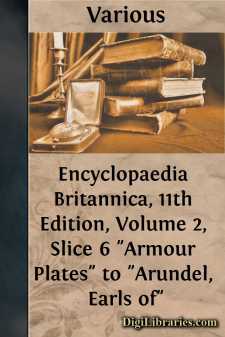Reference
- Atlases 1
- Bibliographies & Indexes 10
- Catalogs 55
- Dictionaries 1
- Encyclopedias
- Etiquette 14
- Handbooks & Manuals 19
- Heraldry 2
- Quotations 9
Encyclopedias Books
Sort by:
by:
Various
ARMOUR PLATES. The earliest recorded proposal to employ armour for ships of war (for body armour, &c., see ) appears to have been made in England by Sir William Congreve in 1805. InThe Timesof the 20thDefence for ships.of February of that year reference is made to Congreve’s designs for an armoured, floating mortar battery which the inventor considered would be proof against artillery fire. Among...
more...
by:
Various
ARAM, EUGENE(1704-1759), English scholar, but more famous as the murderer celebrated by Hood in his ballad, theDream of Eugene Aram, and by Bulwer Lytton in his romance ofEugene Aram, was born of humble parents at Ramsgill, Yorkshire, in 1704. He received little education at school, but manifested an intense desire for learning. While still young, he married and settled as a schoolmaster at Netherdale,...
more...
by:
Various
ATHERSTONE, WILLIAM GUYBON (1813-1898), British geologist, one of the pioneers in South African geology, was born in 1813, in the district of Uitenhage, Cape Colony. Having qualified as M.D. he settled in early life as a medical practitioner at Grahamstown, subsequently becoming F.R.C.S. In 1839 his interest was aroused in geology, and from that date he “devoted the leisure of a long and successful...
more...
by:
Various
ANJAR, a fortified town of India, and the capital of a district of the same name in the native state of Cutch, in the presidency of Bombay. The country is dry and sandy, and entirely depends on well irrigation for its water supply. The town is situated nearly 10 miles from the Gulf of Cutch. It suffered severely from an earthquake in 1819, which destroyed a large number of houses, and occasioned the...
more...
by:
Various
ANDROS, SIR EDMUND (1637-1714), English colonial governor in America, was born in London on the 6th of December 1637, son of Amice Andros, an adherent of Charles I., and the royal bailiff of the island of Guernsey. He served for a short time in the army of Prince Henry of Nassau, and in 1660-1662 was gentleman in ordinary to the queen of Bohemia (Elizabeth Stuart, daughter of James I. of England). He...
more...
by:
Various
ARUNDEL, THOMAS (1353-1414), archbishop of Canterbury, was the third son of Richard Fitzalan, earl of Arundel and Warenne, by his second wife, Eleanor, daughter of Henry Plantagenet, earl of Lancaster. His family was an old and influential one, and when Thomas entered the church his preferment was rapid. In 1373 he became archdeacon of Taunton, and in April 1374 was consecrated bishop of Ely. During...
more...
by:
Various
APOLLODORUS, an Athenian painter, who flourished at the end of the 5th century B.C. He is said to have introduced great improvements in perspective and chiaroscuro. What these were it is impossible to say: perspective cannot have been in his day at an advanced stage. Among his works were an Odysseus, a priest in prayer, and an Ajax struck by lightning. APOLLODORUS, an Athenian grammarian, pupil of...
more...
by:
Various
BEDLAM, or Bethlehem Hospital, the first English lunatic asylum, originally founded by Simon FitzMary, sheriff of London, in 1247, as a priory for the sisters and brethren of the order of the Star of Bethlehem. It had as one of its special objects the housing and entertainment of the bishop and canons of St Mary of Bethlehem, the mother-church, on their visits to England. Its first site was in...
more...
by:
Various
BANKS, GEORGE LINNAEUS (1821-1881), British miscellaneous writer, was born at Birmingham on the 2nd of March 1821. After a brief experience in a variety of trades, he became at the age of seventeen a contributor to various newspapers, and subsequently a playwright, being the author of two plays, a couple of burlesques and several lyrics. Between 1848 and 1864 he edited in succession a variety of...
more...
by:
Various
BASSO-RELIEVO (Ital. for âlow reliefâ), the term applied to sculpture in which the design projects but slightly from the plane of the background. The relief may not project at all from the original surface of the material, as in the sunken reliefs of the Egyptians, and may be nearly flat, as in the Panathenaic procession of the Parthenon. In the early 19th century the term basso-relievo, or...
more...











